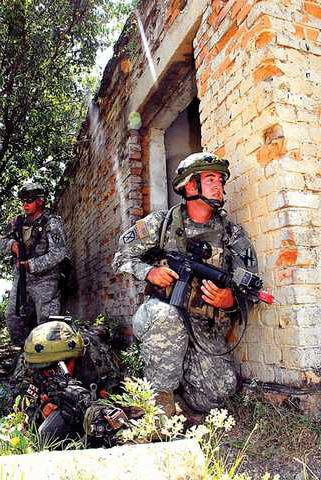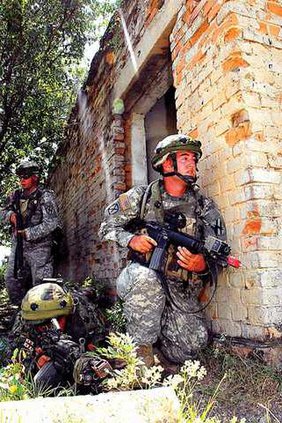As the clash between Russian and Georgian soldiers continues half a world away, a Dawsonville member of the Georgia National Guard said he is concerned for the Georgian soldiers he got to know last month during three weeks of military exercises in their country.
"There’s a personal connection there because of being able to work with these folks and I’m concerned because their line of work takes them into harm’s way," said Maj. John H. Alderman IV, a public affairs officer with the Winder-based 1st Battalion, 121st Infantry Regiment.
"So I’ve been worried about them but I also know that they’re going to do the best that they can, and they’re going to do their job well. And they’re going to serve their country the same way I serve mine."
Alderman, who graduated in 1995 from North Georgia College & State University and lives in Dawsonville, returned with his fellow guard members Aug. 2 from exercises in the country of Georgia. The multinational exercises had been planned since 2006.
Members of both the 121st and the Glenville-based 122nd Rear Operations Center, along with other American forces, spent much of July in the Asian country of Georgia. Some 1,000 Americans and 1,000 soldiers from the countries of Georgia, Ukraine, Armenia and Azerbaijan took part in Immediate Response 2008, featuring coalition forces who will be going to Iraq. "Interoperability," or learning how to work together, is the goal of the annual exercise, Alderman said.Alderman said until last week, the country of Georgia represented the third-largest contributor of coalition forces in Iraq after the United States and United Kingdom. The Georgian army forces began returning home from Iraq when Russians invaded the country on Aug. 8. "It was great to work with (the Georgians). We’re good partners and they’ve been a huge support in the war on terror down in Iraq," Alderman said.
During the July exercises, the 121st worked with the Georgian army, participating in live-fire exercises, practicing maneuvers and taking a Combat Lifesaver course, Alderman said. The 122nd trained the commander of a Georgian army brigade and his staff in how to deploy and lead their troops, he said.
Alderman said the forces were "fully integrated" during the exercises, teaming Americans and Georgians side by side. This required using interpreters and hand signals to communicate, both very valuable skills for coalition forces in Iraq and Afghanistan, Alderman said.
One of the members of the Georgian army Alderman worked closely with lived for a time with relatives in Atlanta — whose sister city is Tblisi — and pointed out that behind New York, the largest number of people from the country of Georgia living in the United States reside in the state of Georgia.
Both Americans and multinational forces also were able to pick up a few words of each other’s languages, which sometimes is all that is needed when dealing with civilians and others in foreign lands, Alderman said.
"That’s great training, too, because many of the places we go in the world, that’s going to be the case. When we’re on the ground in Iraq, we have to be able to communicate with Iraqis," he said. "It’s a great opportunity for soldiers to understand that language matters and if you can learn 10 or 15 words, that makes a difference."
In addition to dealing with language barriers both with civilians and among themselves, the maneuvers practiced by the multinational forces included scenarios that might be common on the ground in Iraq and Afghanistan. Scenarios included establishing a relationship with a local police chief in a mock village and raiding a simulated insurgent bomb-making facility, he said.
"If you’re in a village and someone attacks you, they’re not attacking you in a vacuum on a chessboard where there’s two armies. They’re attacking you in a place where people live and they sell things and they bring their kids to get water and take them to play soccer or whatever," Alderman said. "Because of that, these simulated situational exercises are designed to let them deal with that and they have to understand that that’s part of the battlefield and they have to be careful ... and how do you operate in that environment."
Other than the purely military exercises, Alderman said part of the training also includes time to learn about the culture of the host country. Alderman said he and fellow soldiers got to explore the country of Georgia and meet its people during the three weeks spent there.
American soldiers not only attended Mass at a Georgian Catholic church, but also visited an orphanage outside the capital of Tblisi. The director of the orphanage showed Alderman and fellow troops a decade-old photo that showed members of the Georgia National Guard when American forces last visited the country.
To his amusement, Alderman said that on the road to Tblisi, he saw local farmers selling watermelons out of the trunks of their cars — a reminder of July in the state of Georgia.
The country of Georgia is located on the Black Sea between Russia and Turkey on a confluence of rivers and cultures. It was one of the first Christian nations, established as a kingdom hundreds of years before the Crusades. The Caucasus Mountains separate Georgia from Russia in the region of the breakaway republic of South Ossetia.
The capital is a fairly modern city, Alderman said, and the heart of Tblisi is very Western in appearance with shops, restaurants and book stalls. But outside the capital, it is very clear that parts of the country are deep in poverty, Alderman said. Many areas don’t have paved roads.
The city and other parts of the country also feature monasteries and citadels that are centuries old. Icons of St. George, often depicted in Christian religious art across Europe, also feature prominently across Georgia, Alderman said. Even the country’s flag is a St. George’s cross.
Georgia, currently embroiled again in conflict with Russia, has a long history with its neighbor. As Russia expanded its territory to take over its neighbors, Georgia became part of the Soviet Union in the early 1920s and was a key strategic site for the Soviets. After the Cold War ended and the Soviet Union began to break apart, Georgia declared its sovereignty in 1992. Some breakaway provinces, such as South Ossetia, retain close ties to Russia.
Alderman said the Georgians’ tensions with Russia weren’t a focus for himself or his fellow soldiers. They were simply concentrating on the task at hand: training coalition forces for deployment to Iraq. As a matter of fact, Russians were conducting exercises in their own country and in the Bering Sea with Norway and the U.S.
"We were there for an exercise," Alderman said. "We were there to do our job."
Alderman said the Soviet stamp remains visible across Georgia. Soviet-era bases and military machinery now are in Georgian hands. In Tblisi, many buildings clearly are Soviet architecture, including buildings with friezes featuring hammers from the hammer and sickle that was the symbol of the Soviet Union.
He said much of the construction was similar to what he had seen when he was deployed to Iraq in 2005.
"But the Georgian flag is all over the place and the people are very happy and very friendly," Alderman said.
The country of Georgia "is making its mark," Alderman said. "They have chosen to align themselves with the West."

